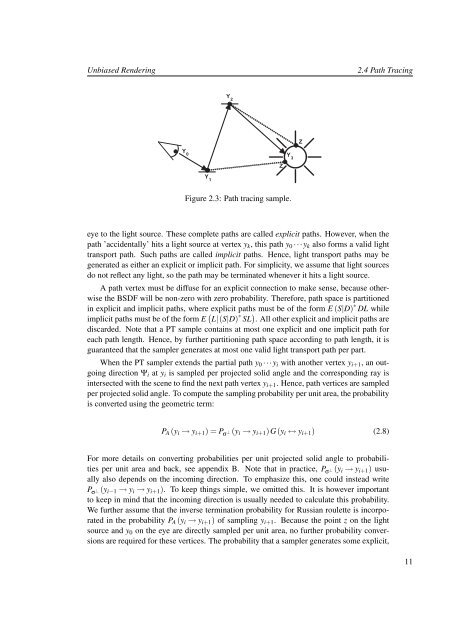Master Thesis - Computer Graphics and Visualization - TU Delft
Master Thesis - Computer Graphics and Visualization - TU Delft
Master Thesis - Computer Graphics and Visualization - TU Delft
Create successful ePaper yourself
Turn your PDF publications into a flip-book with our unique Google optimized e-Paper software.
Unbiased Rendering 2.4 Path Tracing<br />
Y 0<br />
Y 1<br />
Y 2<br />
Figure 2.3: Path tracing sample.<br />
eye to the light source. These complete paths are called explicit paths. However, when the<br />
path ’accidentally’ hits a light source at vertex yk, this path y0 ···yk also forms a valid light<br />
transport path. Such paths are called implicit paths. Hence, light transport paths may be<br />
generated as either an explicit or implicit path. For simplicity, we assume that light sources<br />
do not reflect any light, so the path may be terminated whenever it hits a light source.<br />
A path vertex must be diffuse for an explicit connection to make sense, because otherwise<br />
the BSDF will be non-zero with zero probability. Therefore, path space is partitioned<br />
in explicit <strong>and</strong> implicit paths, where explicit paths must be of the form E (S|D) ∗ DL while<br />
implicit paths must be of the form E L|(S|D) ∗ SL . All other explicit <strong>and</strong> implicit paths are<br />
discarded. Note that a PT sample contains at most one explicit <strong>and</strong> one implicit path for<br />
each path length. Hence, by further partitioning path space according to path length, it is<br />
guaranteed that the sampler generates at most one valid light transport path per part.<br />
When the PT sampler extends the partial path y0 ···yi with another vertex yi+1, an outgoing<br />
direction Ψi at yi is sampled per projected solid angle <strong>and</strong> the corresponding ray is<br />
intersected with the scene to find the next path vertex yi+1. Hence, path vertices are sampled<br />
per projected solid angle. To compute the sampling probability per unit area, the probability<br />
is converted using the geometric term:<br />
PA (yi → yi+1) = P σ ⊥ (yi → yi+1)G(yi ↔ yi+1) (2.8)<br />
For more details on converting probabilities per unit projected solid angle to probabilities<br />
per unit area <strong>and</strong> back, see appendix B. Note that in practice, P σ ⊥ (yi → yi+1) usually<br />
also depends on the incoming direction. To emphasize this, one could instead write<br />
P σ ⊥ (yi−1 → yi → yi+1). To keep things simple, we omitted this. It is however important<br />
to keep in mind that the incoming direction is usually needed to calculate this probability.<br />
We further assume that the inverse termination probability for Russian roulette is incorporated<br />
in the probability PA (yi → yi+1) of sampling yi+1. Because the point z on the light<br />
source <strong>and</strong> y0 on the eye are directly sampled per unit area, no further probability conversions<br />
are required for these vertices. The probability that a sampler generates some explicit,<br />
Z<br />
Y 3<br />
Z<br />
11
















